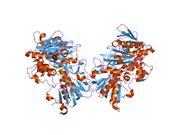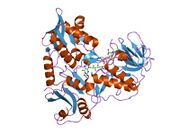Biology:AIFM1
 Generic protein structure example |
Apoptosis-inducing factor 1, mitochondrial is a protein that in humans is encoded by the AIFM1 gene on the X chromosome.[1][2] This protein localizes to the mitochondria, as well as the nucleus, where it carries out nuclear fragmentation as part of caspase-independent apoptosis.[3]
Structure
AIFM1 is expressed as a 613-residue precursor protein that containing a mitochondrial targeting sequence (MTS) at its N-terminal and two nuclear leading sequences (NLS). Once imported into the mitochondria, the first 54 residues of the N-terminal are cleaved to produce the mature protein, which inserts into the inner mitochondrial membrane. The mature protein incorporates the FAD cofactor and folds into three structural domains: the FAD-binding domain, the NAD-binding domain, and the C-terminal. While the C-terminal is responsible for the proapoptotic activity of AIFM1, the FAD-binding and NAD-binding domains share the classical Rossmann topology with other flavoproteins and the NAD(P)H dependent reductase activity.[3]
Three alternative transcripts encoding different isoforms have been identified for this gene.[2] Two alternatively spliced mRNA isoforms correspond to the inclusion/exclusion of the C-terminal and the reductase domains.[3] A pseudogene that is thought to be related to this gene has been identified on chromosome 10.[2]
Function
This gene encodes a flavoprotein essential for nuclear disassembly in apoptotic cells that is found in the mitochondrial intermembrane space in healthy cells. Induction of apoptosis results in the cleavage of this protein at residue 102 by calpains and/or cathepsins into a soluble and proapoptogenic form that translocates to the nucleus, where it affects chromosome condensation and fragmentation.[2][3] In addition, this gene product induces mitochondria to release the apoptogenic proteins cytochrome c and caspase-9.[2] AIFM1 also contributes reductase activity in redox metabolism.[3]
Clinical significance
Mutations in the AIFM1 gene are correlated with Charcot-Marie-Tooth disease (Cowchock syndrome).[3][4] At a cellular level, AIFM1 mutations result in deficiencies in oxidative phosphorylation, leading to severe mitochondrial encephalomyopathy.[2] Clinical manifestations of this mutation are characterized by muscular atrophy, neuropathy, ataxia, psychomotor regression, hearing loss and seizures.[5]
Interactions
AIFM1 has been shown to interact with HSPA1A.[6][7]
Evolution
Phylogenetic analysis indicates that the divergence of the AIFM1 and other human AIFs (AIFM2a and AIFM3) sequences occurred before the divergence of eukaryotes. This conclusion is supported by domain architecture of these proteins. Both eukaryotic and eubacterial AIFM1 proteins contain additional domain AIF_C.[8]
References
- ↑ "Molecular characterization of mitochondrial apoptosis-inducing factor". Nature 397 (6718): 441–6. February 1999. doi:10.1038/17135. PMID 9989411. Bibcode: 1999Natur.397..441S.
- ↑ 2.0 2.1 2.2 2.3 2.4 2.5 "Entrez Gene: AIFM1 apoptosis-inducing factor, mitochondrion-associated, 1". https://www.ncbi.nlm.nih.gov/sites/entrez?Db=gene&Cmd=ShowDetailView&TermToSearch=9131.
- ↑ 3.0 3.1 3.2 3.3 3.4 3.5 "Structural insights into the coenzyme mediated monomer-dimer transition of the pro-apoptotic apoptosis inducing factor". Biochemistry 53 (25): 4204–15. July 2014. doi:10.1021/bi500343r. PMID 24914854.
- ↑ "Cowchock syndrome is associated with a mutation in apoptosis-inducing factor". American Journal of Human Genetics 91 (6): 1095–102. December 2012. doi:10.1016/j.ajhg.2012.10.008. PMID 23217327.
- ↑ "From ventriculomegaly to severe muscular atrophy: expansion of the clinical spectrum related to mutations in AIFM1". Mitochondrion 21: 12–8. March 2015. doi:10.1016/j.mito.2015.01.001. PMID 25583628.
- ↑ "HSP72 inhibits apoptosis-inducing factor release in ATP-depleted renal epithelial cells". American Journal of Physiology. Cell Physiology 285 (6): C1483–93. December 2003. doi:10.1152/ajpcell.00049.2003. PMID 12930708.
- ↑ "Heat-shock protein 70 antagonizes apoptosis-inducing factor". Nature Cell Biology 3 (9): 839–43. September 2001. doi:10.1038/ncb0901-839. PMID 11533664.
- ↑ "Ancestral State Reconstruction of the Apoptosis Machinery in the Common Ancestor of Eukaryotes". G3 8 (6): 2121–2134. May 2018. doi:10.1534/g3.118.200295. PMID 29703784.
Further reading
- "Apoptosis-inducing factor (AIF): a ubiquitous mitochondrial oxidoreductase involved in apoptosis". FEBS Letters 476 (3): 118–23. July 2000. doi:10.1016/S0014-5793(00)01731-2. PMID 10913597.
- "Mitochondrial control of cell death induced by HIV-1-encoded proteins". Annals of the New York Academy of Sciences 926: 149–64. 2001. doi:10.1111/j.1749-6632.2000.tb05609.x. PMID 11193032.
- "Apoptosis-inducing factor (AIF): a novel caspase-independent death effector released from mitochondria". Biochimie 84 (2–3): 215–22. 2002. doi:10.1016/S0300-9084(02)01374-3. PMID 12022952.
- "Mitochondrial apoptosis induced by the HIV-1 envelope". Annals of the New York Academy of Sciences 1010 (1): 19–28. December 2003. doi:10.1196/annals.1299.004. PMID 15033690. Bibcode: 2003NYASA1010...19C.
- "Role of HIV Vpr as a regulator of apoptosis and an effector on bystander cells". Molecules and Cells 21 (1): 7–20. February 2006. PMID 16511342.
- "Classification of biological networks by their qualitative dynamics". Journal of Theoretical Biology 54 (1): 85–107. October 1975. doi:10.1016/S0022-5193(75)80056-7. PMID 1202295. Bibcode: 1975JThBi..54...85G.
- "A "double adaptor" method for improved shotgun library construction". Analytical Biochemistry 236 (1): 107–13. April 1996. doi:10.1006/abio.1996.0138. PMID 8619474.
- "Large-scale concatenation cDNA sequencing". Genome Research 7 (4): 353–8. April 1997. doi:10.1101/gr.7.4.353. PMID 9110174.
- "The central executioner of apoptosis: multiple connections between protease activation and mitochondria in Fas/APO-1/CD95- and ceramide-induced apoptosis". The Journal of Experimental Medicine 186 (1): 25–37. July 1997. doi:10.1084/jem.186.1.25. PMID 9206994.
- "Mitochondrial release of caspase-2 and -9 during the apoptotic process". The Journal of Experimental Medicine 189 (2): 381–94. January 1999. doi:10.1084/jem.189.2.381. PMID 9892620.
- "Mitochondrio-nuclear translocation of AIF in apoptosis and necrosis". FASEB Journal 14 (5): 729–39. April 2000. doi:10.1096/fasebj.14.5.729. PMID 10744629.
- "Essential role of the mitochondrial apoptosis-inducing factor in programmed cell death". Nature 410 (6828): 549–54. March 2001. doi:10.1038/35069004. PMID 11279485. Bibcode: 2001Natur.410..549J.
- "Heat-shock protein 70 antagonizes apoptosis-inducing factor". Nature Cell Biology 3 (9): 839–43. September 2001. doi:10.1038/ncb0901-839. PMID 11533664.
- "DNA binding is required for the apoptogenic action of apoptosis inducing factor". Nature Structural Biology 9 (9): 680–4. September 2002. doi:10.1038/nsb836. PMID 12198487.
- "The C-terminal moiety of HIV-1 Vpr induces cell death via a caspase-independent mitochondrial pathway". Cell Death and Differentiation 9 (11): 1212–9. November 2002. doi:10.1038/sj.cdd.4401089. PMID 12404120.
External links
- AIFM1 on the Atlas of Genetics and Oncology
- Human AIFM1 genome location and AIFM1 gene details page in the UCSC Genome Browser.
 |



